Volvo Group Bundle
Who Really Controls Volvo Group?
Unraveling the ownership of Volvo Group is key to understanding its global dominance in the commercial vehicle and construction equipment sectors. From its humble beginnings in Sweden, the company has evolved into a multinational powerhouse. This deep dive explores the intricate ownership structure that shapes its strategic decisions and market performance.
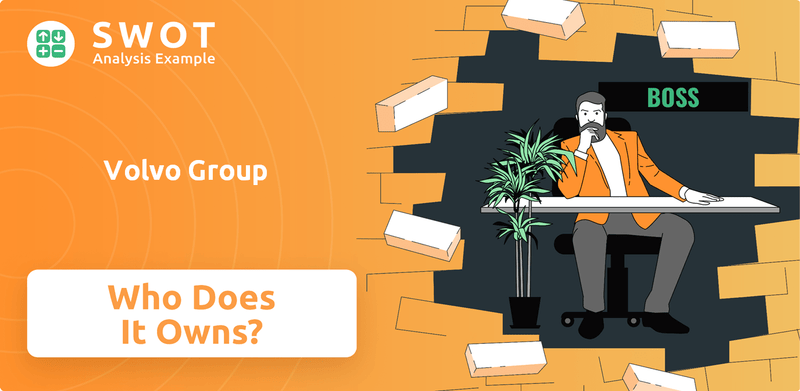
The question of 'Who owns Volvo Group?' is crucial for anyone seeking to understand the company's strategic direction and future prospects. Knowing the Volvo Group SWOT Analysis is important. This article will provide a detailed examination of the Volvo ownership, from the influence of major shareholders to the impact of its parent company, offering insights into how these factors shape one of the world's leading industrial companies. Understanding the Volvo Trucks ownership and the broader Volvo Group's structure is critical for investors, analysts, and anyone interested in the global automotive and construction industries.
Who Founded Volvo Group?
The foundation of the Volvo Group's ownership structure was laid by Assar Gabrielsson and Gustaf Larson. Gabrielsson, with his business and sales background from SKF, and Larson, an engineer, joined forces. They officially founded AB Volvo on April 14, 1927, as a subsidiary of SKF.
Initially, SKF provided the necessary financial backing and resources. This setup allowed the nascent company to develop. While the exact equity splits for Gabrielsson and Larson at the beginning aren't extensively detailed in public records, they functioned more as entrepreneurial leaders within SKF's framework.
Early agreements focused on establishing a solid manufacturing base and market presence. The goal was to produce high-quality, durable vehicles. This vision was reflected in the controlled distribution of resources and decision-making authority, primarily within the SKF corporate structure. The aim was to spin off Volvo as an independent entity once it achieved self-sufficiency and market traction.
Assar Gabrielsson and Gustaf Larson formed the core of Volvo. Gabrielsson brought business acumen, and Larson provided engineering expertise. Their collaboration led to the formal establishment of AB Volvo.
SKF, the Swedish Ball Bearing Company, provided the initial financial support. This backing was crucial for Volvo's early development. SKF's investment allowed Volvo to leverage its industrial capabilities.
The initial focus was on producing high-quality vehicles. The founders aimed to establish a strong manufacturing base. This strategic vision guided the allocation of resources and decision-making.
The long-term goal was to make Volvo independent. The plan was to spin off Volvo once it was self-sufficient. This would allow Volvo to operate autonomously.
The company operated under SKF's umbrella initially. There were no immediate public records of complex ownership arrangements. This structure facilitated a controlled environment for early growth.
Gabrielsson and Larson were key leaders within the SKF framework. Their roles were entrepreneurial, driving the company's early success. They focused on building a strong foundation for the future.
The Volvo Group's history began with a clear vision and strategic backing. The founders' roles were pivotal in shaping the company's early direction. SKF's support was critical for the initial phase of operations, allowing Volvo to concentrate on manufacturing and market development. For more details on how the company generates revenue, you can read about the Revenue Streams & Business Model of Volvo Group.
Volvo Group SWOT Analysis
- Complete SWOT Breakdown
- Fully Customizable
- Editable in Excel & Word
- Professional Formatting
- Investor-Ready Format
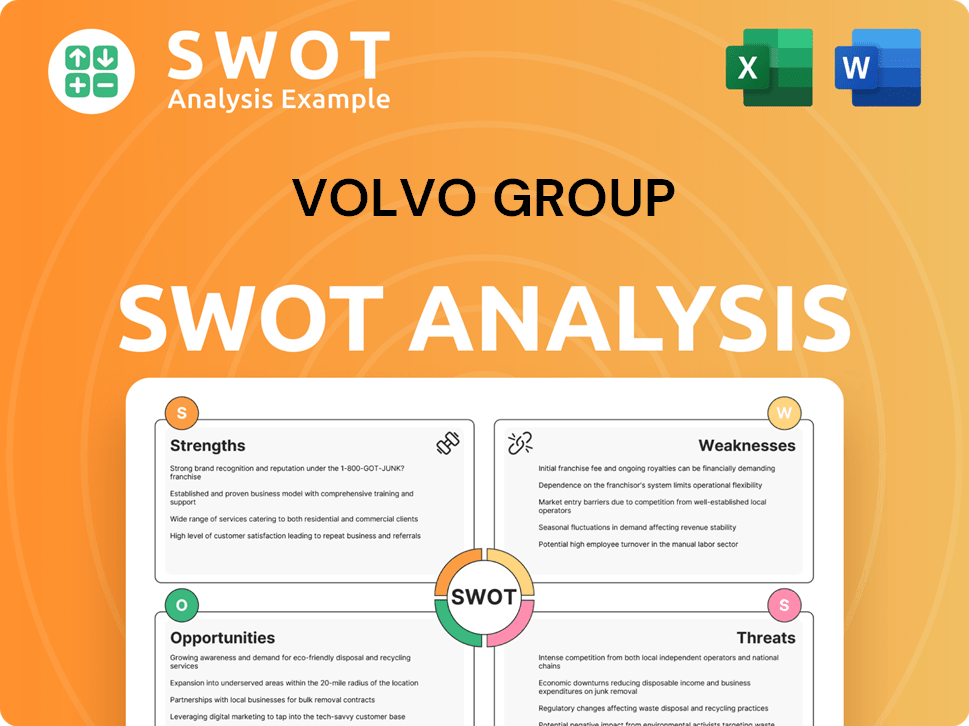
How Has Volvo Group’s Ownership Changed Over Time?
The evolution of Volvo Group's ownership has seen significant changes since its inception. Initially a subsidiary of SKF, the company transitioned to an independent entity through an initial public offering (IPO) in 1935. This IPO marked a crucial turning point, allowing Volvo to raise capital and establish its own corporate identity. The shift from private ownership to public trading on the Stockholm Stock Exchange was a pivotal moment in the company's history, enabling it to expand and grow its operations.
Following the IPO, Volvo Group's shareholder base evolved to include a mix of institutional investors, mutual funds, and individual shareholders. The ownership structure has continued to shift, with major players like Geely Holding Group and Industrivärden becoming significant stakeholders. These shifts have influenced the company's strategic direction, particularly in areas such as market expansion and technological advancements.
| Key Event | Impact | Year |
|---|---|---|
| Initial Public Offering (IPO) | Transitioned from SKF subsidiary to independent public company, enabling capital raising. | 1935 |
| Geely Holding Group's Investment | Became a significant shareholder, influencing strategy and fostering collaborations. | Early 2020s |
| Ongoing Institutional Investment | Maintained a diverse shareholder base with significant influence from investment firms and pension funds. | Ongoing |
As of February 2024, Geely Holding Group was the largest single shareholder by capital, holding 8.2% of the shares and 15.9% of the voting rights. Industrivärden held 27.8% of the voting rights and 7.1% of the capital as of the end of 2023. These ownership dynamics continue to shape the Growth Strategy of Volvo Group, influencing its market positioning and technological developments.
Volvo Group's ownership has evolved significantly since its IPO, with major shifts in shareholder composition.
- Geely Holding Group is a major shareholder, influencing strategy and collaborations.
- Industrivärden and other institutional investors hold substantial stakes.
- The ownership structure impacts market expansion and technological innovation.
- Understanding the Volvo ownership structure is crucial for investors and stakeholders.
Volvo Group PESTLE Analysis
- Covers All 6 PESTLE Categories
- No Research Needed – Save Hours of Work
- Built by Experts, Trusted by Consultants
- Instant Download, Ready to Use
- 100% Editable, Fully Customizable
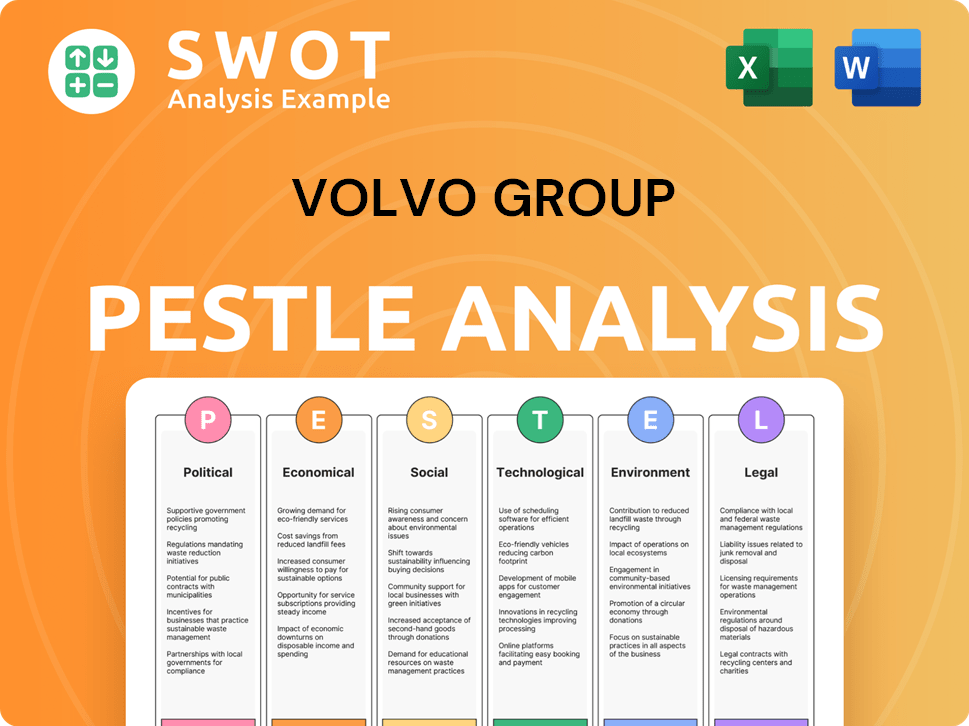
Who Sits on Volvo Group’s Board?
The current Board of Directors of Volvo Group plays a vital role in the company's governance. As of early 2025, the board includes a mix of individuals from various backgrounds and affiliations. Members often include representatives from major shareholders, such as Industrivärden, ensuring their strategic interests are represented. The board's composition reflects a balance between major shareholders, independent members, and employee representatives, contributing to a diverse range of perspectives in decision-making.
The board's structure is designed to oversee the company's strategic direction and ensure accountability to shareholders. The members bring expertise in areas like finance, industry, and international business, which is crucial for navigating the complex global market. This composition helps the company make informed decisions about investments, market strategies, and responses to challenges.
| Board Member | Affiliation | Role |
|---|---|---|
| Martin Lundstedt | CEO, Volvo Group | President and CEO |
| Helena Stjernholm | Industrivärden | Board Member |
| Carl-Henric Svanberg | Investor | Chairman of the Board |
The voting structure of Volvo Group features a dual-class share system. A-shares provide more voting power, while B-shares have less. This structure allows significant shareholders to exert considerable control. For instance, Geely Holding Group held 8.2% of the capital as of February 2024, yet commanded 15.9% of the voting rights due to its A-share holdings. Industrivärden held 27.8% of the voting rights with 7.1% of the capital as of the end of 2023. This concentration of voting power influences decision-making within the company, shaping its strategic direction and investment choices.
The Board of Directors at Volvo Group includes representatives from major shareholders and independent members.
- The dual-class share system gives more voting power to A-shares.
- Geely Holding Group and Industrivärden are key shareholders with significant voting rights.
- The board's composition and voting structure influence the company's strategic direction.
- Understanding Volvo ownership is crucial for investors and stakeholders.
Volvo Group Business Model Canvas
- Complete 9-Block Business Model Canvas
- Effortlessly Communicate Your Business Strategy
- Investor-Ready BMC Format
- 100% Editable and Customizable
- Clear and Structured Layout
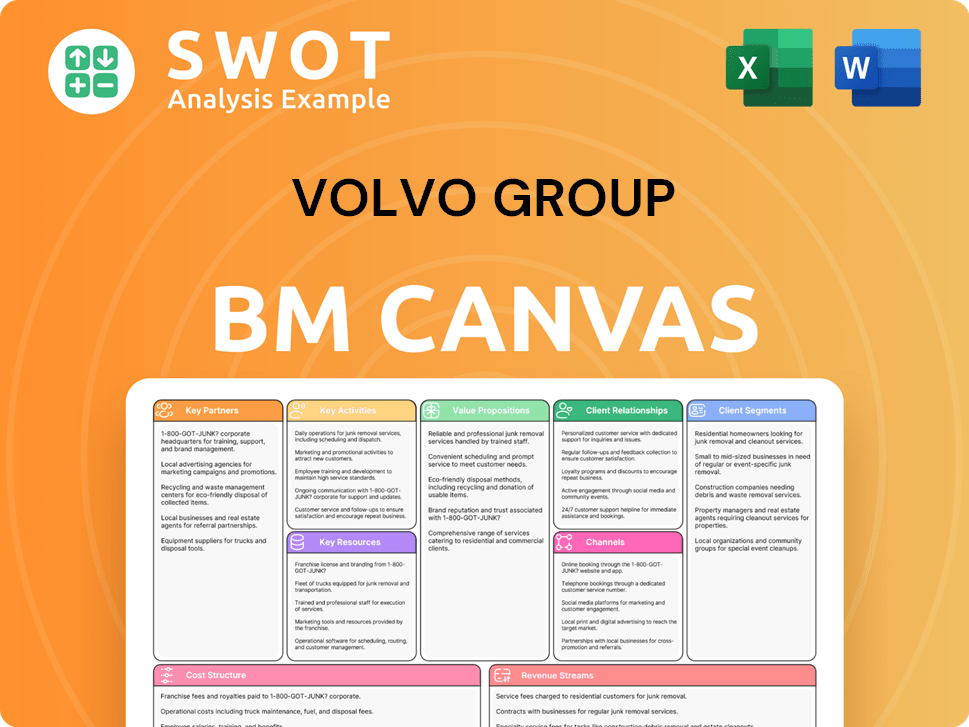
What Recent Changes Have Shaped Volvo Group’s Ownership Landscape?
Over the past few years, the ownership landscape of the Volvo Group has seen the continued influence of its major stakeholders. A general trend towards increased institutional ownership has been observed within the broader market. There have not been major share buybacks or secondary offerings directly impacting the overall ownership structure in a transformative way in late 2024 or early 2025. However, the strategic moves of its largest shareholders remain significant.
For example, Geely Holding Group has maintained its position as a key shareholder since its initial investment in 2017. This continued presence supports Volvo Group's expansion into Asian markets and its advancements in electric vehicle technology. Industrivärden, as a long-term anchor investor, continues to exert significant influence through its substantial voting rights. As of late 2023, Industrivärden held 27.8% of the voting rights, demonstrating consistent strategic involvement. The company is focused on sustained growth, technological innovation, and navigating global economic shifts while maintaining the current shareholder base.
| Shareholder | Approximate Ownership (Voting Rights) | Notes |
|---|---|---|
| Industrivärden | 27.8% (as of late 2023) | Long-term anchor investor |
| Geely Holding Group | Significant | Key shareholder since 2017 |
| Other Institutional Investors | Variable | Increasing institutional ownership |
Industry trends, such as increased institutional ownership and the rise of activist investors, continue to impact companies globally, including Volvo Group. While it has not been a primary target of aggressive activist campaigns in recent years, the general trend of heightened scrutiny from large institutional investors for Environmental, Social, and Governance (ESG) factors and financial performance is ever-present. Founder dilution, a common trend in mature companies, has long since occurred for Volvo as it transitioned from a privately held entity to a publicly traded one.
Geely Holding Group and Industrivärden are the major shareholders, influencing the company's strategic direction. Geely's involvement supports expansion into Asian markets and EV technology. Industrivärden's significant voting rights ensure long-term strategic involvement.
There's a general increase in institutional ownership and scrutiny regarding ESG factors. Volvo Group is focused on sustainable growth and technological innovation. The company aims to navigate global economic shifts while maintaining its current shareholder base.
There have been no major public statements about drastic future ownership changes as of early 2025. The focus remains on sustained growth and technological advancements. The current shareholder base is expected to be maintained.
The company is adapting to global economic shifts and technological advancements. Key areas of focus include electric vehicle technology and expansion in Asian markets. Long-term strategic involvement from major shareholders supports these goals.
Volvo Group Porter's Five Forces Analysis
- Covers All 5 Competitive Forces in Detail
- Structured for Consultants, Students, and Founders
- 100% Editable in Microsoft Word & Excel
- Instant Digital Download – Use Immediately
- Compatible with Mac & PC – Fully Unlocked
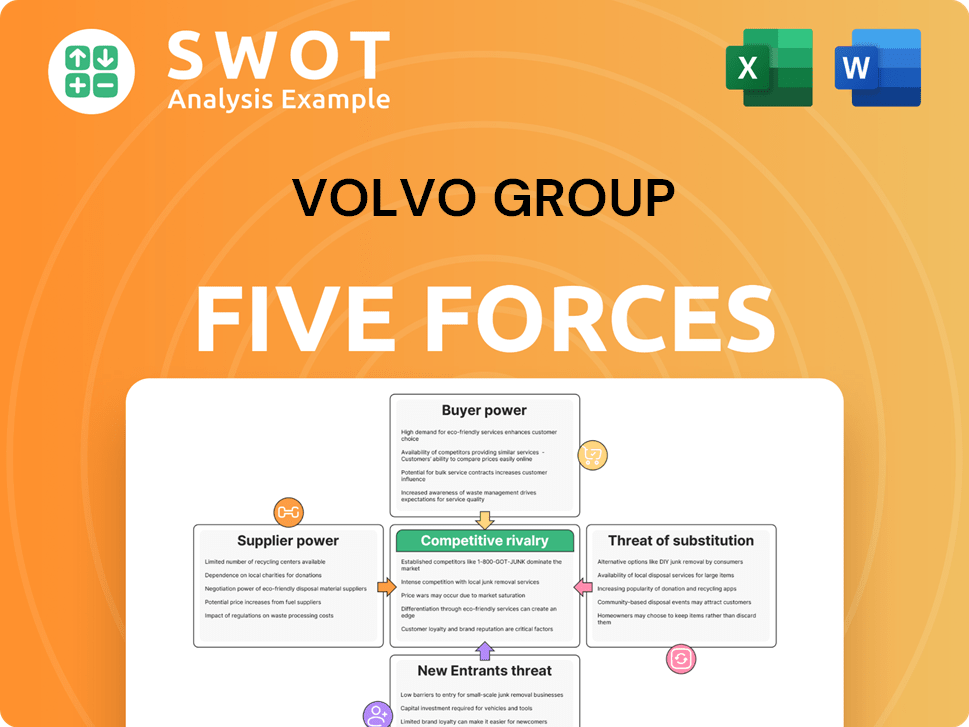
Related Blogs
- What are Mission Vision & Core Values of Volvo Group Company?
- What is Competitive Landscape of Volvo Group Company?
- What is Growth Strategy and Future Prospects of Volvo Group Company?
- How Does Volvo Group Company Work?
- What is Sales and Marketing Strategy of Volvo Group Company?
- What is Brief History of Volvo Group Company?
- What is Customer Demographics and Target Market of Volvo Group Company?
Disclaimer
All information, articles, and product details provided on this website are for general informational and educational purposes only. We do not claim any ownership over, nor do we intend to infringe upon, any trademarks, copyrights, logos, brand names, or other intellectual property mentioned or depicted on this site. Such intellectual property remains the property of its respective owners, and any references here are made solely for identification or informational purposes, without implying any affiliation, endorsement, or partnership.
We make no representations or warranties, express or implied, regarding the accuracy, completeness, or suitability of any content or products presented. Nothing on this website should be construed as legal, tax, investment, financial, medical, or other professional advice. In addition, no part of this site—including articles or product references—constitutes a solicitation, recommendation, endorsement, advertisement, or offer to buy or sell any securities, franchises, or other financial instruments, particularly in jurisdictions where such activity would be unlawful.
All content is of a general nature and may not address the specific circumstances of any individual or entity. It is not a substitute for professional advice or services. Any actions you take based on the information provided here are strictly at your own risk. You accept full responsibility for any decisions or outcomes arising from your use of this website and agree to release us from any liability in connection with your use of, or reliance upon, the content or products found herein.